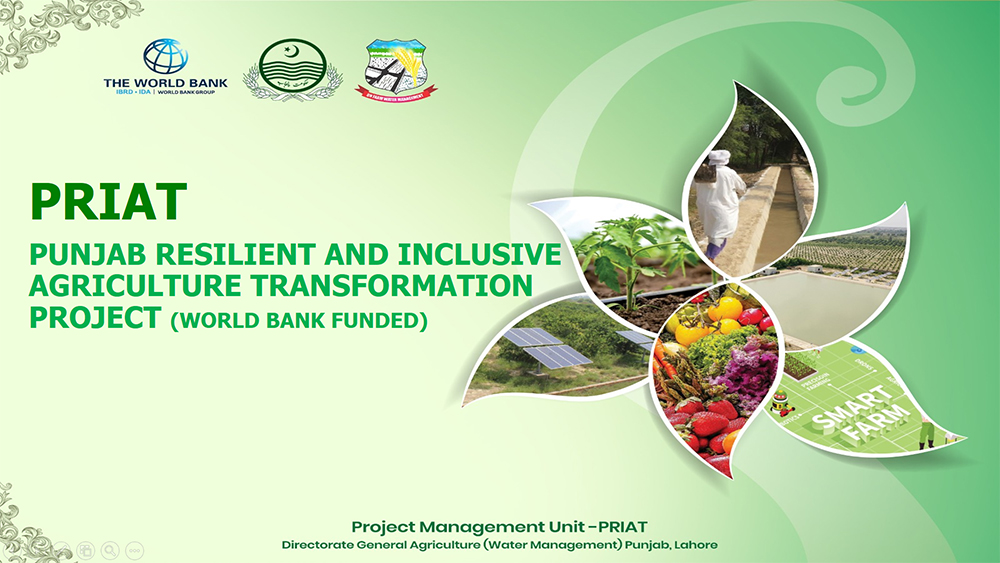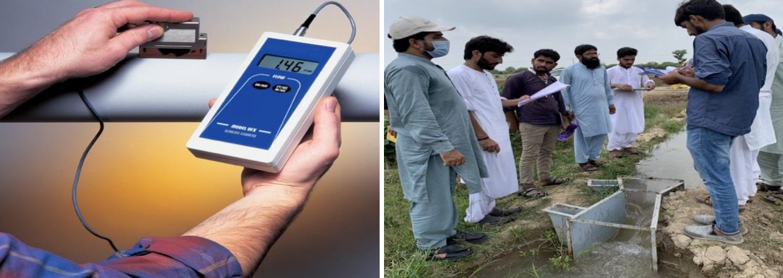 |
 |
Project development objective is to foster equitable access to water, improve productivity of agricultural resources, enhance the incomes of farmers in a sustainable manner, and minimize environmental degradation
The objective of this project is to enhance agriculture by improving on-farm water productivity and profitability of farmers. The project aims to achieve this through various key objectives, such as:
- Improving water conveyance efficiency by developing on-farm irrigation conveyance network in both canal and non-canal command areas.
- Supporting climate-resilient agriculture by promoting reformatory crop production, renewable energy, and on-farm water management technologies.
- Enhancing farmers' profitability through the promotion of high-value crops and agriculture value chain diversification.
- Strengthening private sector service delivery capacity and sustainability for supporting climate-resilient irrigated agriculture.
- Building capacity among stakeholders to adopt climate-smart and high-value agriculture practices for improved farm profitability.
- Generating on-farm green jobs for rural communities, which can help improve their livelihoods and alleviate poverty.
Overall, the goal of the project is to boost agriculture in the region by improving the efficiency of water conveyance, promoting climate-resilient practices, diversifying the agriculture value chain, and supporting private sector involvement. By doing so, the project aims to improve the livelihoods of rural communities and alleviate poverty through the creation of on-farm green jobs.
Project Components
1. The following initiatives are planned to enhance the efficiency of on-farm water conveyance:
- Improving 1,000 currently inefficient watercourses to optimize water flow.
- Extending the lining on 2,000 watercourses to minimize water loss through seepage.
- Reconstructing 1,000 outlived watercourses to restore their function and maximize water use.
- Developing 3,000 irrigation schemes in areas outside of canal commands and riverine zones to expand access to irrigation.
- Creating on-farm irrigation advisory services, such as water budgeting and accounting, on 72 watercourses to assist farmers in managing water resources more effectively.
2. To promote climate-smart production and inclusive access to markets, the following measures will be implemented:
- Regenerative agriculture practices, harvesting, processing, and agricultural value-addition machinery will be promoted to enhance product quality and market value. Improved access to markets will also be facilitated.
- Climate-smart production will be encouraged through the following actions:
- Installation of high-efficiency irrigation systems on 40,000 acres to reduce water consumption and improve crop yields.
- Installation of solar systems to power the high-efficiency irrigation systems on 20,000 acres, to reduce reliance on fossil fuels and lower carbon emissions.
- Provision of certified orchard plants and vegetable seeds/seedlings on 5,000 acres to improve crop varieties and resilience to climate change.
- Development of 1,000 on-farm water storage ponds to enhance water security and reduce the impact of droughts.
3. This involves overseeing, monitoring, and managing projects, as well as raising awareness and building capacity. The aim is to ensure effective project implementation and promote the development of knowledge and skills among stakeholders. Key tasks include project supervision, monitoring and evaluation, communication, capacity building, and strategic studies.
- Overseeing project implementation, monitoring progress, raising awareness, and building capacity
- Conducting project supervision, third-party validation, and monitoring and evaluation
- Providing communication support, capacity building services, strategic studies, and technical assistance in areas such as groundwater management, building construction, and real-time database development
- Managing and supervising projects to ensure successful delivery.
 |
 |
 |
Gestation Period
The project will cover a five-year period, from 2022-23 to 2026-27, during which various activities and tasks will be undertaken to achieve the project objectives. The timeline will be broken down into phases and milestones, with clear deliverables and timelines for each. Regular progress reports and evaluations will be conducted to ensure that the project stays on track and adapts to any changes or challenges that arise.
Project Cost
The total cost of the project is estimated to be Rs. 68,672.560 million, with funding coming from multiple sources. The World Bank will provide Rs. 45,863.560 million (equivalent to USD 200 million or SDR 148.8 million), while the Punjab Government will contribute Rs. 9,072.000 million. In addition, farmers will provide Rs. 13,737.000 million towards the project. These funds will be allocated towards various aspects of the project, including infrastructure development, capacity building, and other activities that support the project objectives. Regular financial monitoring and reporting will be conducted to ensure that the project stays within budget and that funds are utilized effectively.
- Total Project Cost: Rs. 68,672.560 million
- World Bank Share: Rs. 45,863.560 million (USD 200 million/ SDR 148.8 million)
- Punjab Government Share: Rs. 9,072.000 million
- Farmers’ Contribution: Rs. 13,737.000 million
Prequalification Documents
- Installation of High Efficiency Irrigation Systems (HEISs)
-
Installation of Solar Systems For Operating High Efficiency Irrigation Systems (HEISs)
-
Precast Concrete Parabolic Segments (PCPS) for Waterourse lining
Environmental and Social Management Framework
The Environmental and Social Management Framework (ESMF) is a tool used to assess the potential risks and impacts of a program or series of subprojects when the details of each individual component are not yet known. It provides guidelines, principles, rules, and procedures for identifying and mitigating environmental and social risks and impacts. As part of the PRIAT project, several documents have been prepared that outline measures and plans for reducing, mitigating, or offsetting any adverse impacts or risks that may arise. These documents will be used to guide the project team in their efforts to ensure that the project is implemented in a socially and environmentally responsible manner.
- Executive Summary in Urdu Language
- Environmental and Social Commitment Plan (ESCP)
- Environmental and Social Management Framework (ESMF)
- Gender Mainstreaming and Gender-based Violence (GBV), Sexual Harassment (SH) and Sexual Exploitation & Abuse (SEA) Action Framework
- Stakeholder Engagement Plan (SEP)
- Labour Management Procedures (LMP)
- Annexes
EOIs
-
Request for Expression of Interest (Selection of Monitoring & Evaluation Consultants). Published on 17.08.2022.
-
Request for Expression of Interest (Selection of Project Implementation Supervision & Third Party Validation Consultants). Published on 17.08.2022.
